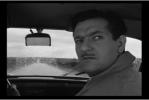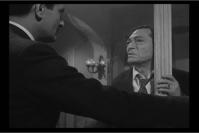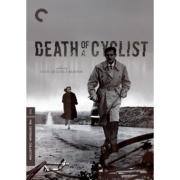§ It's an accident, although you don't really see it... conclusively. A cyclist passes, going up hill, and when he disappears over the crest, you hear a car swerve, and the clatter of the bicycle as it hits the pavement. Moments later a woman appears on the crest, bends down. The victim remains an off-stage action, even when the camera cuts to the scene. You see the woman -- a beautiful woman in a fur coat -- staring down at the victim, and the mangled frame of his bicycle. Her car -- a black Fiat saloon -- is parked further along the road, which extends into the desolate landscape as a long straight section. She is joined by a man wearing a trenchcoat, who crouches down and stares in shock as if contemplating the future rather than the unseen, anonymous victim.
A common technique of the film thriller, the "withholding of information" might seem to be a cheap trick for those who believe in "strict point-of-view", although here it might be for reasons of symbolic possibility rather than easy suspense. Film directors have never paid much attention to the literary notion of strict POV anyway, preferring the visual appeal of unlikely and even impossible angles. So you have an accident you didn't see which becomes a crime because the woman and the man drive away from the scene without reporting the incident. Why would they do this? Because the woman was behind the wheel, and because their clandestine love affair would be exposed.




